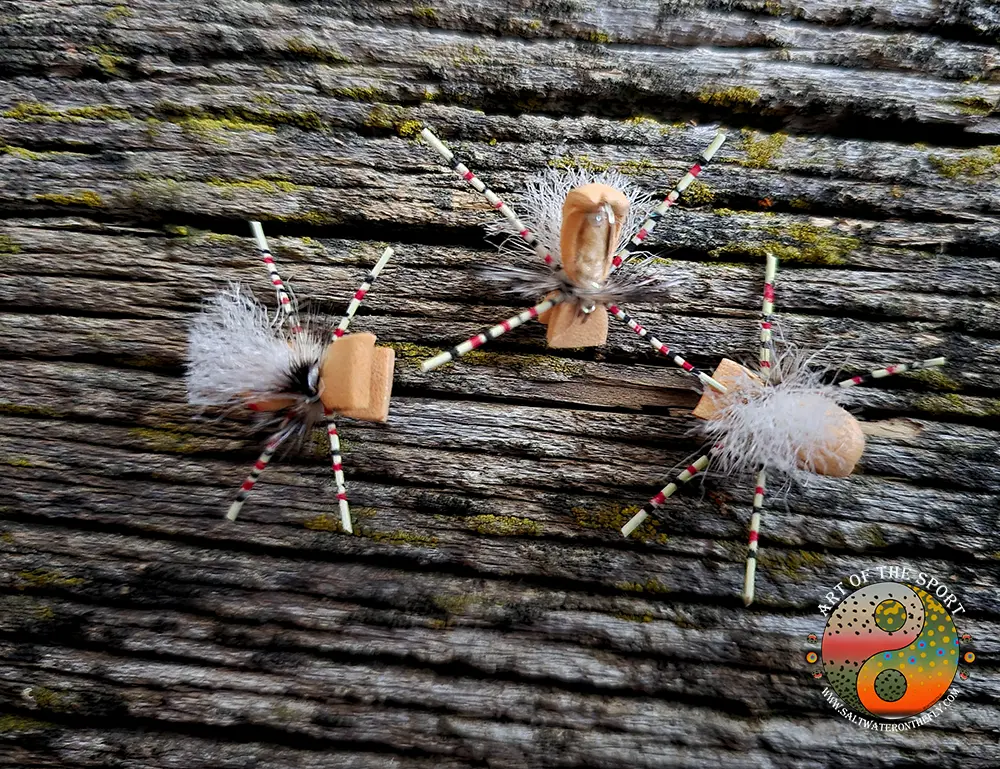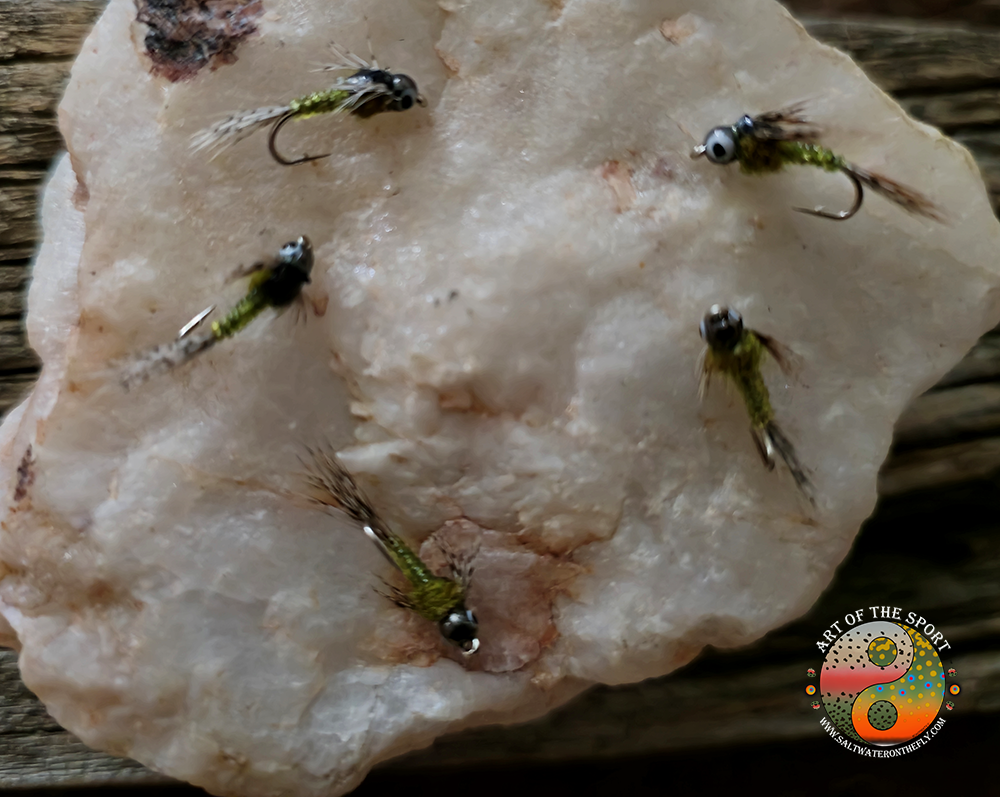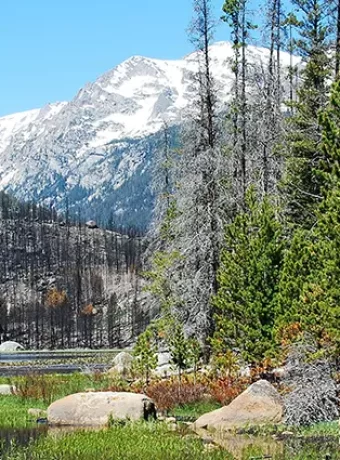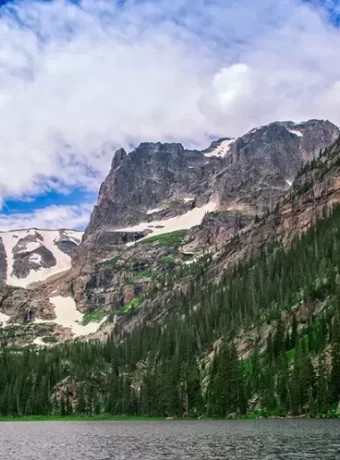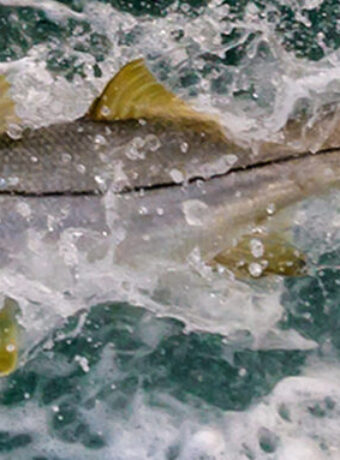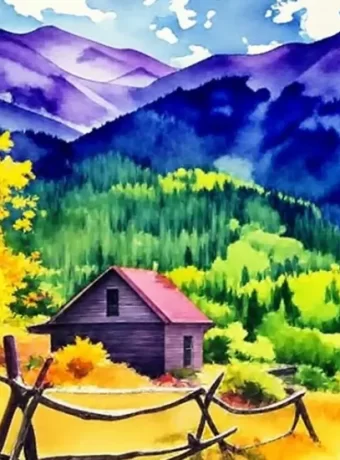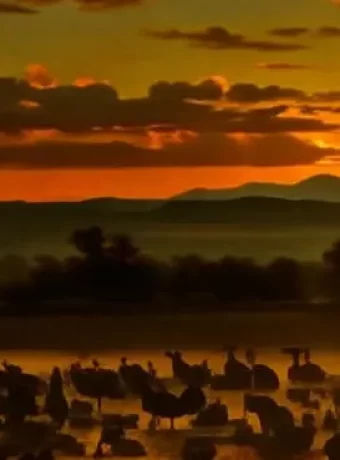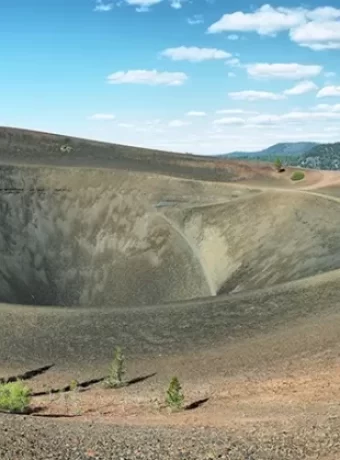Explore Custer State Park and Mount Rushmore National Memorial Plan Your adventure
Nestled in the Black Hills of South Dakota, Custer State Park and Mount Rushmore National Memorial offer a blend of natural beauty and American history. These destinations draw millions yearly, eager to experience the landscapes, wildlife, and monumental sculptures. Whether you are a history buff or seeking a family vacation, Custer State Park and Mount Rushmore National Memorial provide a journey through America’s stunning scenery and significant landmarks.
I have visited Custer State Park and Mount Rushmore multiple times without any disappointment. Black Hills have an energy that touches me very deeply.
Table of Contents
Exploring the Wonders of Custer State Park
Custer State Park, South Dakota’s oldest and largest state park, spans 71,000 acres. From rolling prairies to granite spires, the park offers natural wonders and recreational opportunities.
Wildlife Encounters
A main attraction is the park’s abundant wildlife. It is home to a free-roaming herd of nearly 1,300 bison, one of the largest publicly-owned herds.
These creatures can be spotted grazing along the Wildlife Loop Road, an 18-mile drive through the park’s southern region. Other animals you might encounter in Custer State Park include pronghorn antelope, elk, bighorn sheep, mountain goats, deer, and wild burros.
Scenic Drives in Custer State Park
Needle Highway-The Dream Lee Michael Howard
Camping, Hiking, Fly Fishing Bison Graphic Hoodie.
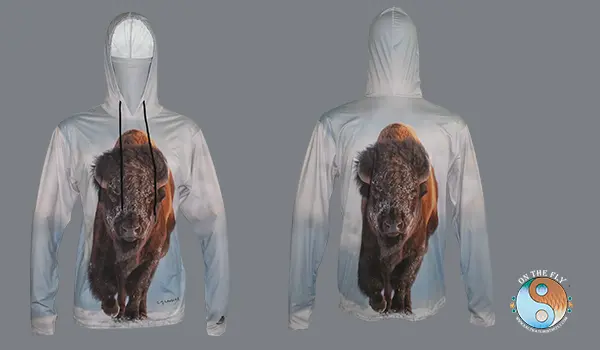
Bison Graphic Hoodie is Great for Hiking
Driving The Needles Highway
Custer State Park thrills visitors with granite spires that pierce the sky. The Needles Highway winds through these amazing formations. This 14-mile drive is a must-do. But this isn’t your average Sunday drive. The road twists and turns. It’s narrow with some tight tunnels. It’s not for the faint of heart! But it’s totally worth it.
This scenic drive starts at the intersection of Highway 16A and the Wildlife Loop Road. Follow the signs for Needles Highway, also known as SD-87. The granite needles tower above you. They look like giant needles. It’s an unbelievable sight. Sylvan Lake sits nestled among the peaks. This makes a perfect spot to stretch your legs and snap some photos.
A thrill awaits you at the Eye of the Needle. You’ll drive through a narrow tunnel carved right through the rock. Make sure your vehicle can fit! Check the height restrictions before you go. This is a tight squeeze, even for some cars. Next, you’ll encounter the Cathedral Spires. These huge rock formations rise like a cathedral. Their stained-glass-like colors add to the beauty.
The Needles Highway has many parking areas and viewpoints. This lets you stop and soak in the scenery. Keep your eyes peeled for wildlife. Bison, deer, and elk roam freely in Custer State Park. Watch for them near the road. The whole drive takes about one to two hours. But this depends on how often you stop.
Driving the Needles Highway is an unforgettable experience. It’s one of the highlights of Custer State Park. The beauty of the Black Hills will blow you away. The granite needles and spires create a unique landscape. The nearby Mount Rushmore National Memorial adds historical significance to the area. This road includes narrow tunnels carved through rock, including the “Eye of the Needle.” The Iron Mountain Road connects Custer State Park to Mount Rushmore. This 17-mile journey features stunning vistas, pigtail bridges, and tunnels framing Mount Rushmore.
Outdoor Activities Fly Fishing & Hiking Custer State Park
For outdoor enthusiasts, Custer State Park offers many activities, including over 70 miles of hiking trails. These trails range from nature walks to challenging backcountry treks.
Some popular trails include the Sunday Gulch Trail, Sylvan Lake Shore Trail, and Black Elk Peak Trail. Fishing enthusiasts will find opportunities in the park’s five lakes and streams. These waters are stocked with trout, making it popular for fly fishing.
Hiking Black Elk Peak Trail
Black Elk Peak, formerly known as Harney Peak, is the highest point not only in South Dakota, but also in the entire Black Hills range. It reaches a height of 7,242 feet. This makes it a tough but rewarding hike for anyone visiting Custer State Park.
The most popular route to the summit is the Black Elk Peak Trail, a 7.5-mile out-and-back trek. This trail begins near Sylvan Lake. You’ll gain about 1,000 feet in elevation. This makes for a moderately challenging climb. But the stunning views from the summit are totally worth it.
As you hike, you’ll pass through beautiful forests of pine and spruce trees. Keep your eyes open for local wildlife, like deer and maybe even a mountain goat! The trail is well-maintained. However, some sections can be rocky and steep, so good hiking boots are essential.
At the top of Black Elk Peak, you’ll find a fire tower built in the 1930s by the Civilian Conservation Corps. Although you can’t go inside, it adds a cool historical element to the summit. From the peak’s summit, you can see for miles in every direction. You’ll take in breathtaking views of the Black Hills, Custer State Park, and the surrounding plains.
This hike usually takes about four to six hours to complete. So it’s a good idea to start early in the day. Pack plenty of water and snacks, because there are no facilities along the trail. And remember, weather in the Black Hills can change quickly, so layers are always a smart choice.
If you’re looking for a shorter hike, consider starting from the trailhead at Sylvan Lake. This shaves a few miles off the total distance. But you’ll still get to experience some beautiful scenery and a good workout. No matter which route you choose, hiking Black Elk Peak is a great way to experience the natural beauty of Custer State Park. This adventure is definitely one for the books.
Streamers are a great fly pattern and woolly buggers rate among the best.
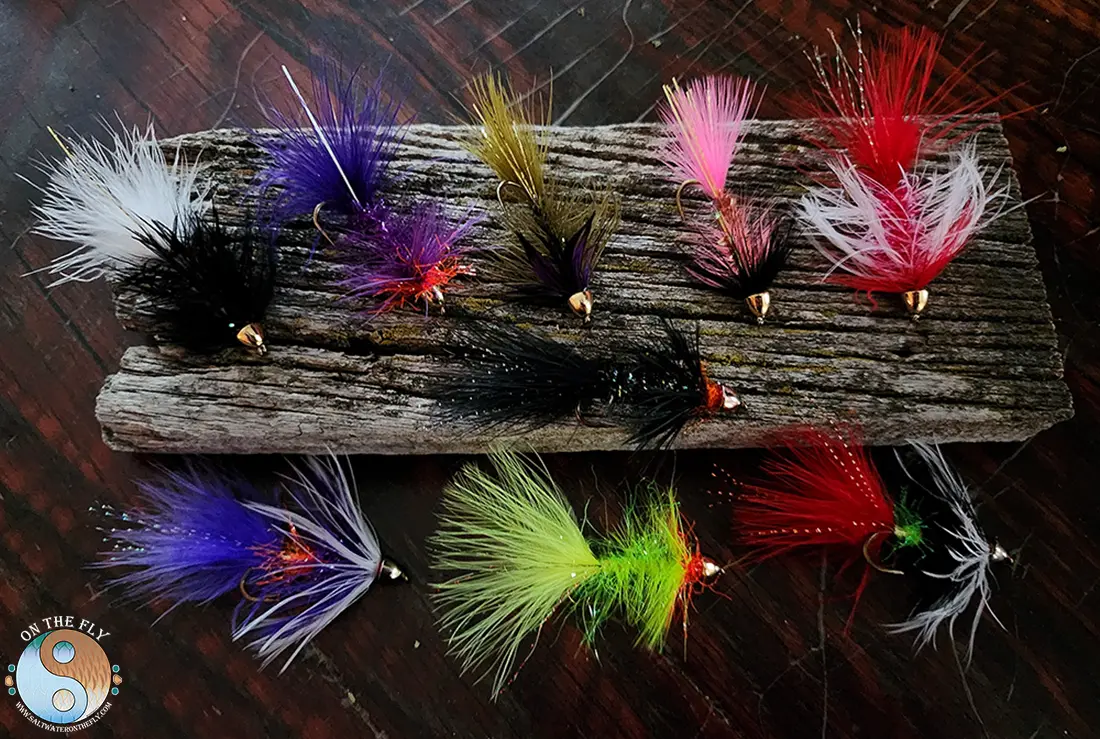
Woolly Buggers in Various Sizes for Local South Dakota Rivers and Streams
Sun Protective Fishing Gloves with a stripping finger are a must on the water. They also make great driving and hiking gloves.
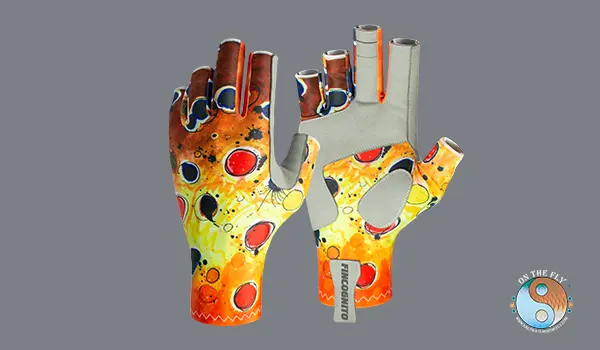
Sun Protective Fishing Glovess
Backpack Centennial Trail
Grab your boots and a hefty backpack. It’s time to talk about the epic Centennial Trail in the Black Hills. This 111-mile trek winds right through Custer State Park and offers stunning views. But it’s not a walk in the park. This challenging adventure takes experienced backpackers through diverse terrain.
The Centennial Trail isn’t just long; it’s a true test of endurance. Be ready for steep climbs, rocky paths, and changing weather. You’ll cross streams, walk through forests, and hike across open prairies. This trail throws everything at you.
Planning is key for this multi-day trip. You’ll need a detailed map and a solid itinerary. Reserve your campsites in advance. Water sources can be scarce, so bring a water filter or purification tablets. And pack layers because the Black Hills weather can change quickly.
Wildlife is abundant in Custer State Park. You might spot bison, elk, or even bighorn sheep. Keep a safe distance. Carry bear spray and know how to use it. Safety should always be your top priority.
Although the Centennial Trail is tough, it rewards hikers with unbelievable beauty. Imagine reaching Harney Peak, the highest point in the Black Hills. The panoramic views are worth every challenging step. This trail offers a deep connection with nature and a real sense of accomplishment.
So, are you ready for an unforgettable backpacking adventure? The Centennial Trail awaits. Just remember to train, plan carefully, and pack smart. The Black Hills are calling, and this epic trail will deliver a lifetime of memories.
Fly Fish Custer State Park
Custer State Park in South Dakota offers fantastic fly fishing. The Black Hills streams and lakes are full of trout. This makes it a great spot for fly fishermen of all skill levels. Go Fly Fish South Dakota.
Here are some top spots:
- French Creek: This is a good spot for brook trout. The creek has areas of fast and slow-moving water.
- Deerfield Creek: This creek is known for its brown trout. You’ll find a mix of riffles and pools here.
- Sunday Gulch Creek: This is a smaller stream. It’s home to both brook and brown trout.
- Deerfield Lake: This big lake has lots of rainbow trout.
- Stockade Lake: This smaller lake has brook and rainbow trout.
- Sylvan Lake: This pretty lake also has brook and rainbow trout.
Here are a few tips for fly fishing in Custer State Park:
- Dry Flies: During summer, try dry flies like Elk Hair Caddis, Stimulator, or Hopper.
- Nymphs: In spring and fall, nymphs work well. Try Hare’s Ear, Pheasant Tail, or Copper John.
- Streamers: Also in spring and fall, try streamers like Woolly Bugger or Muddler Minnow.
What to bring:
- A 9-foot 6-weight rod and reel with a strong drag system.
- An assortment of dry flies, nymphs, and streamers.
- Waders or boots with good grip, because the streams can be slippery.
- Polarized sunglasses will help you see the fish and cut down on glare.
- Sunscreen and bug spray will keep you comfortable.
Don’t forget, you’ll need a South Dakota fishing license. The daily limit is four trout per person. Each trout must be at least 12 inches long. Catch-and-release fishing helps keep the trout population healthy. Fishing early in the morning can help you avoid the crowds. This is often the best time to catch trout.
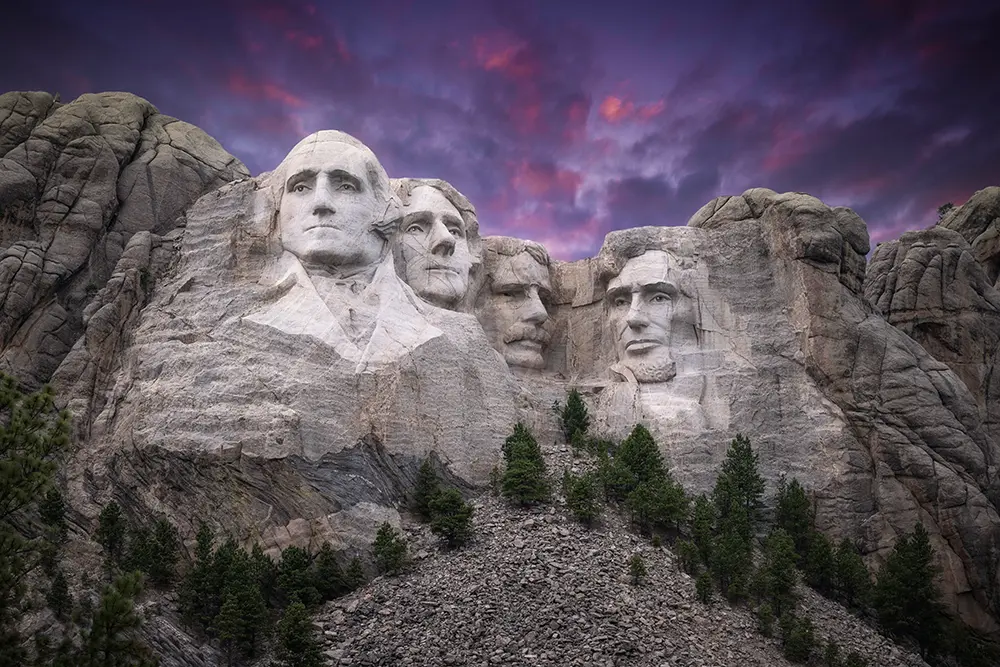
Mount Rushmore National Memorial
The Majesty of Mount Rushmore National Memorial
Near Custer State Park is Mount Rushmore National Memorial. This colossal sculpture features the 60-foot-tall faces of Presidents George Washington, Thomas Jefferson, Theodore Roosevelt, and Abraham Lincoln. The national memorial draws visitors from around the world.
History and Construction
The idea for Mount Rushmore was conceived in 1923 by South Dakota historian Doane Robinson, to attract tourists. Sculptor Gutzon Borglum was commissioned, and work began in 1927.
The construction took 14 years. Workers used dynamite to blast away 400,000 tons of granite. They then sculpted the presidential faces using pneumatic hammers and chisels. The project was completed in 1941.
Toughest Part of Carving Mount Rushmore
Carving Mount Rushmore? Sounds easy, right? Just get some chisels, a hammer, and bam! Presidential faces on a mountain. But hold on. It wasn’t a walk in the park. Gutzon Borglum and his crew faced a ton of challenges. They carved gigantic presidential heads into the granite of the Black Hills of South Dakota.
Think about the sheer size of this thing. Mount Rushmore National Memorial is massive! Each head is 60 feet tall. That’s like a six-story building. It’s a huge project.
So, what was the toughest part? Many people would guess it was the actual carving. Although tough, they used dynamite. It blasted away big chunks of rock. This made the job a little faster. After the dynamite, they still needed more precision. Workers used a technique called “honeycombing.” They drilled small holes close together. Then, they removed small bits of rock. This gave them amazing control over the shape of the faces.
But, the real headache? The Black Hills weather. South Dakota can get brutal. Imagine blizzards in the winter, scorching heat in the summer, and surprise thunderstorms anytime. These conditions made working on the mountain incredibly dangerous. High winds could knock workers right off the scaffolding. Ice would make the rock slippery and impossible to climb.
This unpredictable weather caused constant delays. This made the whole project take way longer than anyone expected. Fourteen years! That’s longer than most people spend in school.
Also, the rock itself wasn’t exactly cooperative. The granite on Mount Rushmore has different layers. Some layers are hard. Some are soft. Some have cracks. These differences made carving tricky. Borglum had to carefully plan where each part of the face would go. He had to find solid rock. He had to avoid the weak spots.
Custer State Park is just a short drive from Mount Rushmore. This makes it a great home base for exploring both. You can see wildlife and camp. You can enjoy all sorts of outdoor activities. But the story of Mount Rushmore’s creation is a testament to human grit. It shows how people can overcome difficult conditions. This makes the massive sculpture even more impressive.
Visiting Mount Rushmore National Memorial
When visiting Mount Rushmore, walk the Presidential Trail. This half-mile loop offers close-up views of the sculpture and informational exhibits.
| Activity | Description |
|---|---|
| Presidential Trail | A half-mile loop offering close-up views and exhibits. |
| Sculptor’s Studio | Learn about the tools and techniques used. |
| Evening Lighting Ceremony | (Summer) The memorial is illuminated with a patriotic program. |
| Lincoln Borglum Visitor Center | Explore interactive exhibits and a 14-minute film. |
Planning Your Visit to Custer State Park and Mount Rushmore National Memorial
Best Time to Visit the Black Hills
The peak season is summer (June-August). However, this is the busiest time, with larger crowds. For a more peaceful experience, consider spring (April-May) or fall (September-October).
The weather is still pleasant during these times. You might catch sight of wildlife preparing for the changing seasons, and the Black Hills scenery will be spectacular.
Accommodation Options
Custer State Park lodging options range from rustic cabins to resorts. Several options are the State Game Lodge, and Sylvan Lake Lodge. For those preferring to camp, Custer State Park has several campgrounds.
Nearby Attractions
The Black Hills region offers other attractions worth exploring, such as Crazy Horse Memorial, Wind Cave National Park, Badlands National Park, and Deadwood.
FAQs about Custer State Park and Mount Rushmore National Memorial
Can you do Custer State Park and Mount Rushmore in one day?
Visiting both in one day is possible but not ideal. Plan for at least two to three days. This allows time for scenic drives, wildlife viewing, hiking, and exploring Mount Rushmore.
How far apart are Crazy Horse and Mount Rushmore?
Crazy Horse Memorial is about 17 miles southwest of Mount Rushmore. The drive takes about 30 minutes.
Who was the fifth face on Mount Rushmore?
There is no fifth face. The monument features four presidents: George Washington, Thomas Jefferson, Theodore Roosevelt, and Abraham Lincoln.
What is the best month to visit Mount Rushmore?
The best time to visit Mount Rushmore is May to October when the weather is mild. September and October are good, with fewer crowds and fall colors.
Conclusion of Custer State Park and Mount Rushmore National Memorial
Custer State Park and Mount Rushmore National Memorial offer visitors a chance to experience the beauty of the American West and human artistry. From the rugged landscapes and wildlife of Custer State Park to the sculpture of Mount Rushmore, these destinations provide unforgettable experiences. Whether you seek outdoor adventures, historical insights, or a peaceful retreat, Custer State Park and Mount Rushmore National Memorial promise a journey filled with lasting memories. Your road trip through western South Dakota will provide an appreciation for America’s natural and cultural heritage. A great visit is Casey Tibbs Rodeo Center.

